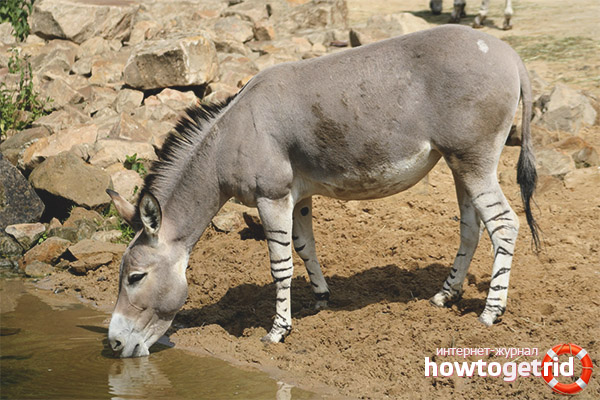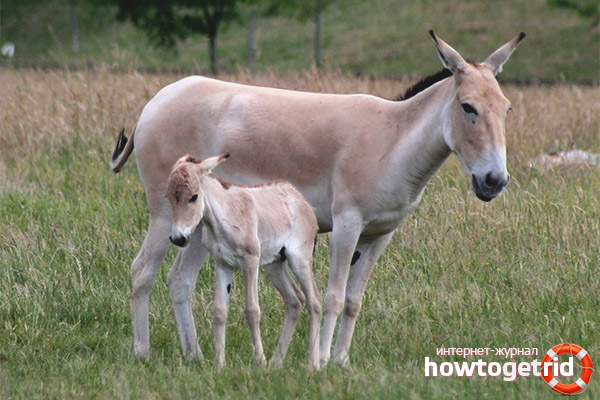The content of the article
The wild donkey belongs to the equine family, a unit of artiodactyls. The domesticated form of these animals has long played an important role in economic activity and culture. Scientists have established that the genus Equus arose about 4.5 million years ago. It was from him that modern donkeys came.
Appearance
The height of adults varies from 90 to 155 cm. Wild donkeys are very similar to horses in the anatomical structure. Horses have 6 lumbar vertebrae, while the wild donkey has 5.
But in appearance, the difference between these animal species from each other is more pronounced. Donkeys have a larger head size. Their ears are longer and thicker. A rather long coat grows inside the ears. Their body is elongated, and the croup is short. Donkeys can have a different color. There are individuals of gray, black, brown color. There are also breeds of donkeys of white color. On the stomach, around the eyes and in front of the muzzle, the coat is white. The tail and mane are covered with stiff bristles. There is a brush at the end of the tail. The withers are not strong, and the mane is short. A dark stripe runs along the back in the middle. Depending on the subspecies, there may still be stripes on the body located on the legs or shoulders of the animal.
The hooves of representatives of the species are black. Their heels are high, they are slightly flattened on the sides. The hooves are very well adapted for movement in mountainous areas. But they are not meant to be fast jumps. In this case, the donkey can accelerate to 70 km / h.
Food
Due to their unpretentiousness, for a long time they can eat scarce food containing very few nutrients that they can get in the desert.
They eat twigs of bushes, grass, acacia. A wild donkey can do without water for a long time. Usually they drink 1 time in several days. This sets them apart from other ungulates in Africa who need water daily.
Habitat
Today, these animals can only be seen in Ethiopia, Djibouti, as well as in countries such as Sudan and Somalia. They are also found in Eritrea. A small population lives in one of the Israeli reserves. In the 80s, the total number of representatives of the species was only about 1000 individuals. In subsequent years, their number decreased. During the civil war in Somalia, they completely disappeared. Researchers fear that soon the same thing will also happen in Ethiopia.
The population is preserved only by Eritrea. About 400 wild donkeys live there.
In addition to the usual wild donkeys, there are also domestic donkeys, which again run wild. There are a lot of such animals around the world. They are also where wild donkeys originally live. Scientists consider this a dangerous phenomenon, since there is a high probability of mixing. After that, the genetics of pure wild donkeys will be lost.
About 1.5 million donkeys live in the Australian steppes. In the southwestern United States, there are about 6,000.
Wild donkeys live in Cyprus, as well as on the Karpas Peninsula. Their coat is dyed black or brown. Compared to wild donkeys, they are somewhat larger, and they have stripes on their legs that resemble a pattern on the body of zebras.
Views

Today in nature there are 2 subspecies. They live in Somalia, in northern Ethiopia, as well as in Eritrea.A population of these animals is also off the coast of the Red Sea.
The individuals that live in Somalia are large. They are dark in color and have dark stripes on their legs. They live near the Gulf of Aden. These are Somali wild donkeys.
Another subspecies is the Nubian wild donkeys. They are somewhat smaller than their counterparts. The specimens are lighter, the “dorsal cross” is clearly visible on the back. Representatives of the subspecies live in Sudan, northern Ethiopia, as well as in Eritrea. Females and males do not have external differences.
Behavior
This species has not been studied well enough. They usually live in a semi-desert, desert. They live in family herds, as do zebras. Each such group has a leader. This is usually an old donkey. In addition to him, the group includes young individuals and about 10 females. Since they constantly have to find food and a source of water, family herds wander from place to place, moving over considerable distances. Their behavior is always careful.
Domestic donkeys, called donkeys, are much more common. They are descendants of wild donkeys. Most individuals are gray in color. But there are also black, brown and even white. The coat can be either long or short. Curly donkeys are sometimes found.
Breeding
At the age of 2-2.5 years, wild donkeys become sexually mature. Most often, mating occurs in the spring, but can be at any other time of the year. During this period, males, which are usually characterized by calm behavior, become very temperamental. Those who do not have a pair begin the fight with the leaders. The fight is not particularly cruel. She is less calm than many other artiodactyls. Males can stand on their hind legs, bite the opponent by the leg or neck. During the mating season, males emit loud non-melodic cries.
Duration of pregnancy - 1 year, sometimes delayed up to 14 months. Usually 1-2 babies are born. Immediately after birth, they are well developed. At 6-8 months, they already begin to live independently. Prior to this, the female feeds them with milk. They grow up to two years of age. Sometimes they cross with horses, after which mules are born. In captivity, representatives of the species can live for about 21-25 years.
Enemies in nature
Since donkeys usually live in an area with an unfavorable climate. In nature, they have almost no enemies. Previously, they often became victims of lions, but today their habitats do not overlap.
Despite this, the number of wild donkeys is decreasing. They have been under guard for a long time. Human activity is the reason for the decline in numbers.
Real wild donkeys today around the world there are about 500 individuals. To save the species, and increase the number of individuals, they began to breed artificially. In captivity, they are quickly tamed.
Interesting Facts
- A donkey can transport two adults on its back over a fairly large distance.
- In ancient times, there were a lot of wild donkeys in northern Africa. A few millennia BC, individuals were domesticated by the Egyptians. They were used for household purposes. These animals are very strong and hardy; they tolerate a hot climate well.
Video: wild donkey (Equus asinus)











Submit